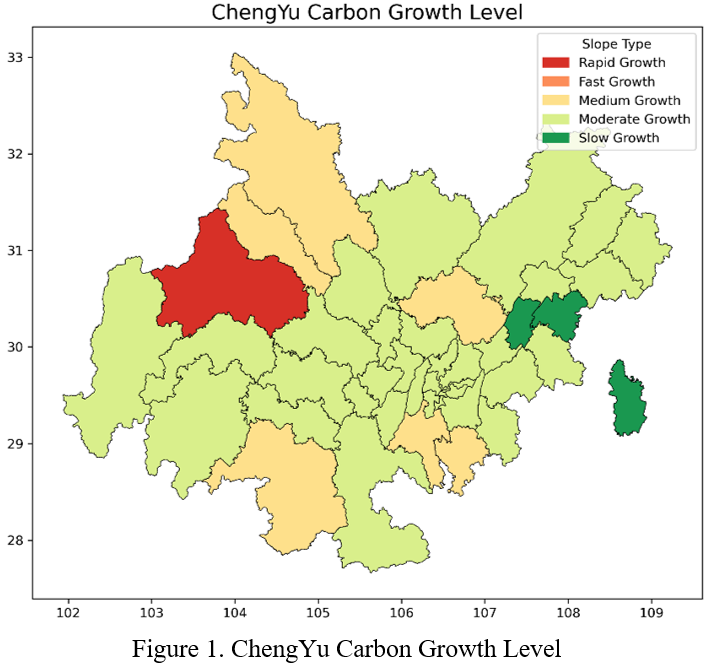Spatiotemporal Evolution of Carbon Emissions in the Chengdu-Chongqing Region
Abstract
This study analyzes the spatiotemporal dynamics of carbon emissions in the Chengdu-Chongqing urban agglomeration from 2000 to 2022 using nighttime light (NTL) data, Moran’s I analysis, and centroid analysis. The results reveal significant regional disparities in carbon emissions, with rapid growth observed in northwestern cities such as Chengdu, Mianyang, and Deyang, while southeastern regions, including Chongqing’s urban core, show phase-specific increases. The carbon emission centroid exhibits a general northwestward shift, reflecting the growing contribution of Sichuan’s industrial cities, with temporary southeastward movements indicating localized emission surges in Chongqing. Moran’s I analysis demonstrates a transition from strong spatial clustering in the early 2000s to spatial dispersion by 2022, driven by urbanization and regional policy interventions.
The study highlights the importance of region-specific strategies to address emission disparities, promote sustainable development, and achieve carbon neutrality. Recommendations include enhancing renewable energy adoption, improving energy efficiency, and strengthening regional coordination. By leveraging spatial tools and dynamic modeling, this research provides valuable insights into carbon emission management in rapidly urbanizing regions like the Chengdu-Chongqing urban agglomeration.
References
Anselin, L. (1995). Local indicators of spatial association-LISA. Geographical Analysis, 27(2), 93–115. https://doi.org/10.1111/j.1538-4632.1995.tb00338.x
Doll, H. C., Muller, J., & Elvidge, D. C. (2000). Night-time imagery as a tool for global mapping of socioeconomic parameters and greenhouse gas emissions. AMBIO: A Journal of the Human Environment, 29(3), 157–162.
Elvidge, C. D., Cinzano, P., Pet, D. R., et al. (2007). The nights at mission concept. International Journal of Remote Sensing, 28(12), 2645–2670. https://doi.org/10.1080/01431160600981519
Elvidge, C. D., et al. (1999). Radiance calibration of DMSP-OLS low-light imaging data of human settlements. Remote Sensing of Environment, 68(1), 77–88. https://doi.org/10.1016/S0034-4257(98)00098-4
Feng, Y., & Liu, Z. (2021). Regional disparities and driving factors of the Chengdu-Chongqing economic circle. Finance & Economics Science, (05), 63–76.
Kuang, K., Zheng, K., Chen, R., et al. (2023). Spatiotemporal evolution of county-level economic development in Fujian Province based on NPP-VIIRS nighttime light data. Regional Research and Development, 42(04), 29–35.
Li, C., Chen, X., Li, X., et al. (2013). Potential of NPP-VIIRS nighttime light imagery for modeling the regional economy of China. Remote Sensing, 5(6), 3057–3081. https://doi.org/10.3390/rs5063057
Li, D., & Li, X. (2015). Applications of nighttime light remote sensing in assessing economic and social development—With a discussion on its role in ensuring the quality of the "Belt and Road" initiative. Macroeconomic Quality Research, 3(04), 1–8.
Li, Y., Hu, Y., Shang, G., et al. (2022). Carbon effect calculation of land consolidation projects: A case study of Jing County, Hebei Province. China Rural Water and Hydropower, 150–155.
Li, Y., Li, Y., Wu, B., et al. (2023). Light pollution research in Yunnan Province using nighttime light imagery. Remote Sensing Information, 38(05), 98–105.
Lin, B., & Liu, X. (2010). Carbon emissions at China's urbanization stage: Influencing factors and mitigation strategies. Economic Research Journal, 45(08), 66–78.
Liu, B., Wang, B., Niu, H., et al. (2019). Atmospheric pollutant emission inventory of fixed combustion sources in Urumqi City. Environmental Pollution & Control, 41(7), 748–752.
Liu, F., Zhu, X., Chen, J., et al. (2018). Multidimensional and multi-scale quantitative identification of urban shrinkage and its causes—A case study of Northeastern China during the transition period. Modern Urban Research, (07), 37–46.
Liu, Z., Wang, A., Yu, W., et al. (2010). Research on regional carbon emissions in China. Acta Geoscientica Sinica, 31(05), 727–732.
Lu, H., & Shi, J. (2012). Analysis of surface soil water and its changing trends in China during the early 21st century based on remote sensing observations. Chinese Science Bulletin, 57(16), 1412–1422. https://doi.org/10.1007/s11434-012-5081-3
Ma, D., Cheng, H., Mao, Y., et al. (2017). A study on the inter-provincial economic development level evaluation model based on DMSP/OLS nighttime light imagery. Journal of Applied Sciences, 35(05), 647–657.
Ozturk, I., & Acaravci, A. (2010). CO2 emissions, energy consumption, and economic growth in Turkey. Renewable & Sustainable Energy Reviews, 14, 3220–3225. https://doi.org/10.1016/j.rser.2010.07.005
Ren, X. (2013). Research on the relationship between energy carbon emissions and environmental quality in Jiangsu Province [Master’s thesis, Nanjing Normal University].
Schimel, D. S., et al. (1995). CO2 and carbon cycle. In Climate Change 1994: Radioactive Forcing of Climate Change (IPCC) (pp. 35–37). Cambridge University Press.
Shu, Y. (2012). Spatiotemporal characteristics of carbon emissions from energy consumption in China. Acta Ecologica Sinica, 32(16), 4950–4960.
Song, D., & Yi, Y. (2011). Foreign direct investment and China's carbon emissions. China Population, Resources, and Environment, 21(01), 49–52.


This work is licensed under a Creative Commons Attribution 4.0 International License.
Copyright for this article is retained by the author(s), with first publication rights granted to the journal.
This is an open-access article distributed under the terms and conditions of the Creative Commons Attribution license (http://creativecommons.org/licenses/by/4.0/).
























